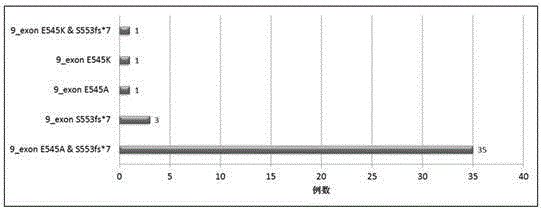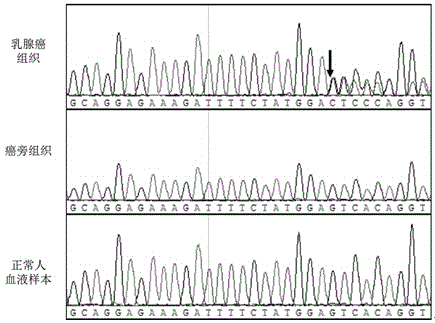Breast cancer PIK3CA mutant gene and application thereof
A technology for mutating genes and breast cancer, applied in the fields of application, genetic engineering, plant gene improvement, etc., can solve the problem that PIK3CA gene breast cancer has not been reported, and achieve good practical application value
- Summary
- Abstract
- Description
- Claims
- Application Information
AI Technical Summary
Problems solved by technology
Method used
Image
Examples
Embodiment 1
[0021] Example 1: DNA Extraction in Breast Cancer and Paracancerous Tissues
[0022] 1. Experimental materials
[0023] TES buffer (wash a 50mL centrifuge tube, after high temperature and high pressure sterilization, add 0.5mL of 1M Tris-HCL, 1mL of 0.5M EDTA and 2.5mL of 10% SDS, add ultrapure water to make up to 50mL, adjust the pH to 8.0 Store at room temperature), 20mg / mL proteinase K, 3M sodium acetate (pH=5.2), TEBuffer, phenol, chloroform, isoamyl alcohol, absolute ethanol, TE solution.
[0024] 2. Experimental method
[0025] 2.1 Thaw the tissue block, cut about 0.5g of tissue, put it into a 1.5mL centrifuge tube, and cut it into pieces;
[0026] 2.2 Add 0.45mL LTES buffer and mix well, then add 50μL SDS (10%), 5.0μL proteinase K (20mg / mL), mix well, digest at 56°C for 4-6h, shake once every 2h until the solution is clear;
[0027] 2.3 Place it at room temperature, add an equal volume of saturated phenol (500 μL), invert to mix, 12000 rpm, centrifuge for 10 minute...
Embodiment 2
[0033] Embodiment 2: DNA extraction in blood sample
[0034] 1. Experimental materials
[0035] White blood cell lysate, red blood cell lysate, proteinase K (10mg / mL), phenol, chloroform, isoamyl alcohol, absolute ethanol, TE solution.
[0036] 2. Experimental method
[0037]2.1 Transfer 4mL of fresh blood to a 15mL centrifuge tube, add red blood cell lysate, mix upside down, centrifuge at 4000g at 4°C for 15min;
[0038] 2.2 Remove the supernatant and wash the blood repeatedly 2-3 times;
[0039] 2.3 Remove the supernatant, add 1mL leukocyte lysate, vortex and mix evenly, divide evenly into two 1.5mL centrifuge tubes, and store one tube at -80°C for later use;
[0040] 2.4 Add 20 μL proteinase K (10 mg / mL) to another tube, gently invert 8 times to mix, incubate overnight at 56°C (until there is no visible suspension), and invert occasionally to mix;
[0041] 2.5 Add an equal volume of saturated phenol (500 μL), invert and mix well, centrifuge at 12,000 rpm for 10 minute...
Embodiment 3
[0047] Example 3: PCR amplification of exon 9 of PIK3CA gene and sequencing
[0048] 1. Experimental materials
[0049] 2×PfuMix, DNA template extracted in Examples 1 and 2, deionized water, forward and reverse primers for amplifying exon 9 of PIK3CA gene (see Table 1 for details), PCR machine, 1% agarose gel ,Electrophoresis.
[0050] Table 1
[0051]
[0052] 2. Experimental method
[0053] 2.1 Select DNA samples with better quality in Examples 1 and 2, including 88 cases of breast cancer tissue DNA, 19 cases of breast cancer paracancerous tissue DNA, and 22 cases of normal human blood sample DNA;
[0054] 2.2 Configure the PCR reaction system in the following table:
[0055] Table 2
[0056] .
[0057] 2.3 Reaction conditions: ①94°C, 5min pre-denaturation; ②94°C, 30s denaturation; ③55°C, 30s annealing; ④72°C, 35s extension; cycle ② to ④35 times; ⑤72°C, 5min;
[0058] 2.4 After the PCR reaction is completed, spread 1% gel for detection and send it to Sangon Bio...
PUM
 Login to View More
Login to View More Abstract
Description
Claims
Application Information
 Login to View More
Login to View More - R&D
- Intellectual Property
- Life Sciences
- Materials
- Tech Scout
- Unparalleled Data Quality
- Higher Quality Content
- 60% Fewer Hallucinations
Browse by: Latest US Patents, China's latest patents, Technical Efficacy Thesaurus, Application Domain, Technology Topic, Popular Technical Reports.
© 2025 PatSnap. All rights reserved.Legal|Privacy policy|Modern Slavery Act Transparency Statement|Sitemap|About US| Contact US: help@patsnap.com



